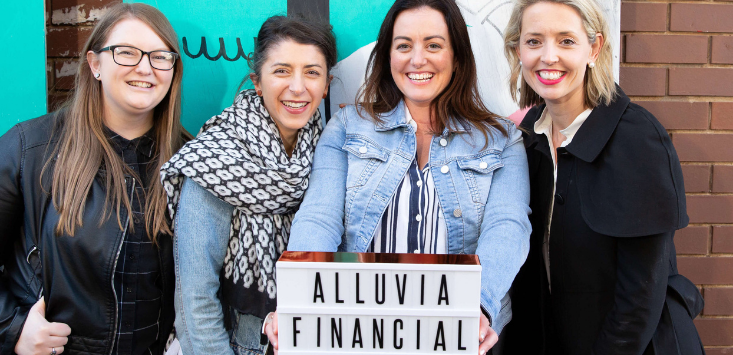
Jo Doye, pictured with the Alluvia Financial team. Source: Supplied.
Jo Doye, director at Alluvia Financial, understands better than most the stress that end of financial year (EOFY) can bring for the self-employed. When she transitioned from a corporate career to a smaller bookkeeping firm, her duties were far from streamlined: she would drive to each client’s workplace, hop onto their computer and do as much tax work as possible in the allotted time — only to do it all over again a week or two later.
When Doye started using Xero she began to see the true value of having an accounting solution that allowed her to do all of her clients’ financial and tax tasks without having to physically be on their computer — particularly for her self-employed clients who were already short on time.
“We’ve been 100% Xero for quite some time now. It’s really good to be consistent with the one platform across all our clients. It’s allowed us to streamline our processes and add the relevant apps depending on their industry,” she says.
Doye says that tax time is often a stressful period for business owners, especially self-employed sole traders. Managing paperwork, organising time to see an accountant, making sure suppliers are being paid and clients are paying their invoices. It can seem overwhelming if you don’t have a clear path to follow.
So, in the spirit of stress-relieving solutions for tax time, here are Doye’s top three focus points for sole traders as EOFY approaches.
1. Adopt an automated accounting solution
First and foremost, Doye says, sole traders absolutely should be integrating automated accounting software to ease their administrative burden.
“If you’re not already on an automated accounting system, then you need to spend the time now to get yourself online. And if you do have a system in place, make sure you’ve got all the information reconciled and up to date,” Doye says.
“Because if you’re not recording this information, then it’s going to be a scramble come tax time to find all your receipts, or to work out how much money you’ve made or haven’t made, and to make sure you’re claiming everything that you can for this financial year.”
Just as crucial to make your tax time easier, according to Doye, is choosing relevant apps that connect to an accounting solution. Using the Xero App Marketplace, for example, self-employed business owners can use direct-debit solutions like GoCardless or Stripe, while HubDoc is ideal for automated invoice capturing.
2. Book an appointment with an accountant or bookkeeper
Next, it’s time to engage the services of a financial professional. If you haven’t already done so, speak to people who work in the same industry as you, as they may be able to recommend a good bookkeeper. You can also jump online and search for an accountant who specialises in your sector — if you’re a wholesale coffee supplier, for example, finding a financial expert who already has years of experience working with clients in food services and distribution could be a huge weight off your shoulders.
“Book in an appointment with your advisor, whether that’s an accountant or bookkeeper, and have a conversation about how your business has gone this year.
“That way, they can start understanding your financial situation and do some tax planning so you don’t end up with a giant tax bill at the end of the financial year — which can happen if you’re not prepared for it.”
Doye says this is also a good opportunity to look at your goals for the next 12 months. Almost half (48%) of sole traders say strategic planning and dealing with the unknown are major challenges, so your advisor can help you prepare for the year ahead and give you tips to achieve those goals.
Whether you lead a small team or are going it alone, you’ll find the support you need at Xero’s dedicated resource page — complete with free tools and guides to help everything run smoothly. Xero is online accounting software designed to let you do business beautifully and simply, nab a free 30-day trial today.
3. Improve your payment processes
Last, but certainly not least, Doye advises looking into your payment processes. Established sole traders should look into how their current payment processes could be improved, whether that’s through digital software or physical direct-debit devices for on-the-go transactions. For new sole traders, it’s worth spending a bit of time researching the different solutions available to you, and then choosing a payment process that matches your needs — for example, an on-the-go tradie will need a different way to accept payments (mobile point-of-sale system) than a freelancing web designer (online transfer).
“If customers are unable to pay on the spot — or if they’re not expected to pay on the spot — then it can take a long time for sole traders to receive those payments,” she says. “So you need to make it as easy as possible for people to pay you, whether that’s setting up direct debits with ongoing clients or having a point-of-sale system so you can take payments on the spot.
“Depending on the industry, that may mean using something like Stripe or another specific retail point-of-sale. Or if you’re in e-commerce, you must make sure your online shop is set up and working properly.” That means putting yourself in the customer’s shoes and actually going through the sales funnel yourself. Are there any roadblocks or reasons why customers may leave their shopping carts abandoned? You may also like to A/B test the online shopping experience to see if any minor tweaks could increase sales.
Turning a traditionally challenging time of year on its head
Doye reiterates the value of getting expert advice from a professional.
“If you are someone who is not necessarily financially minded, there can be a lot of uncertainty for the self-employed around whether they are doing the right things, or whether they should be doing more with their financials,” she says.
“At Alluvia Financial, we typically meet with our clients once a month — or at least once every quarter. Even if it’s just to listen to their concerns and tell them that ‘yes’ they have thought of everything or ‘no’ they aren’t quite on the right track. Getting an educated eye across their accounts gives them peace of mind.
“It just takes the stress and unease out of tax time.” And less stress means you can focus on what’s really important to your business: from spending more time building relationships with clients, to tweaking your current offering to get ahead of the competition, and focusing on how you can grow and thrive in the future.



COMMENTS
Reader comments have been turned off on this post.